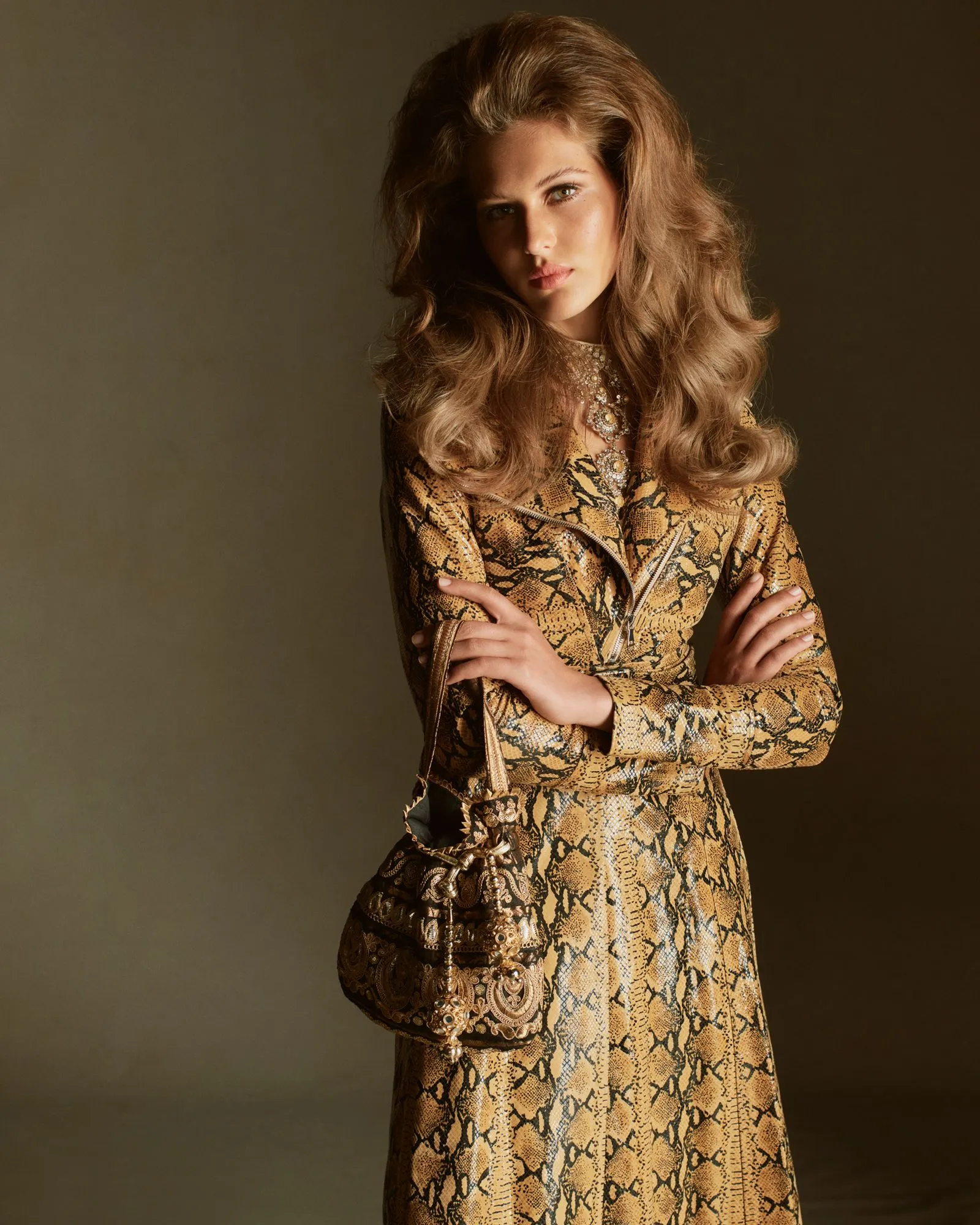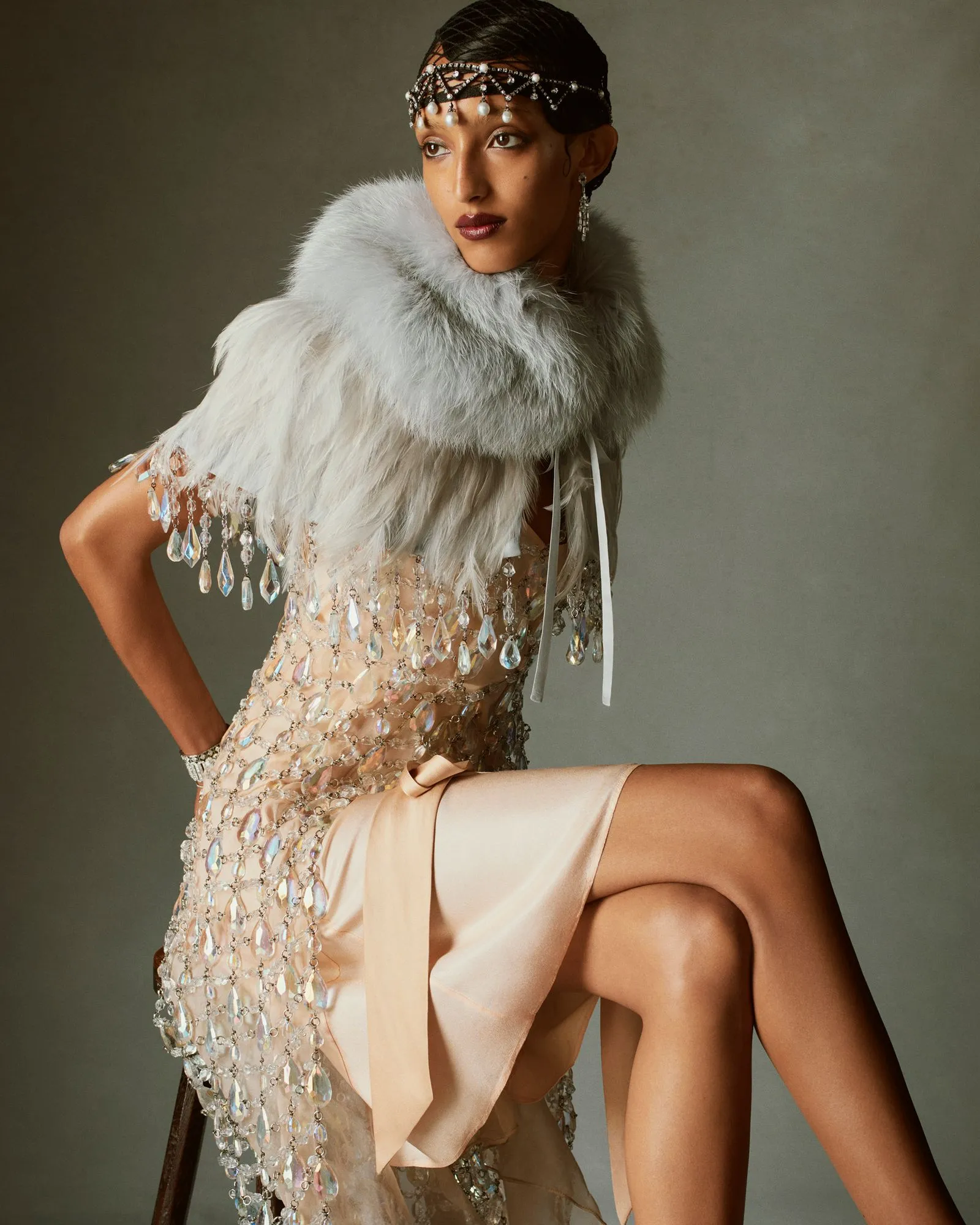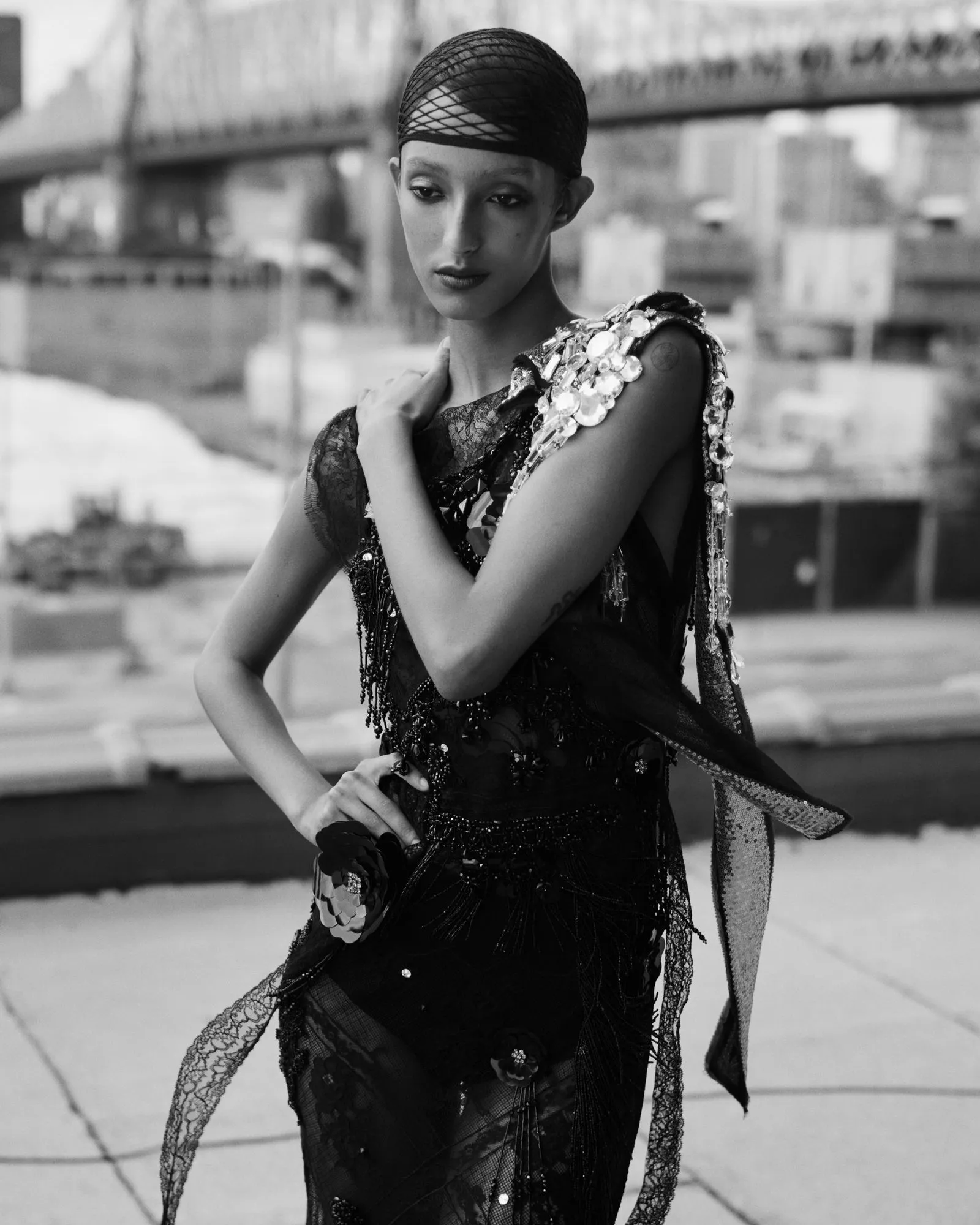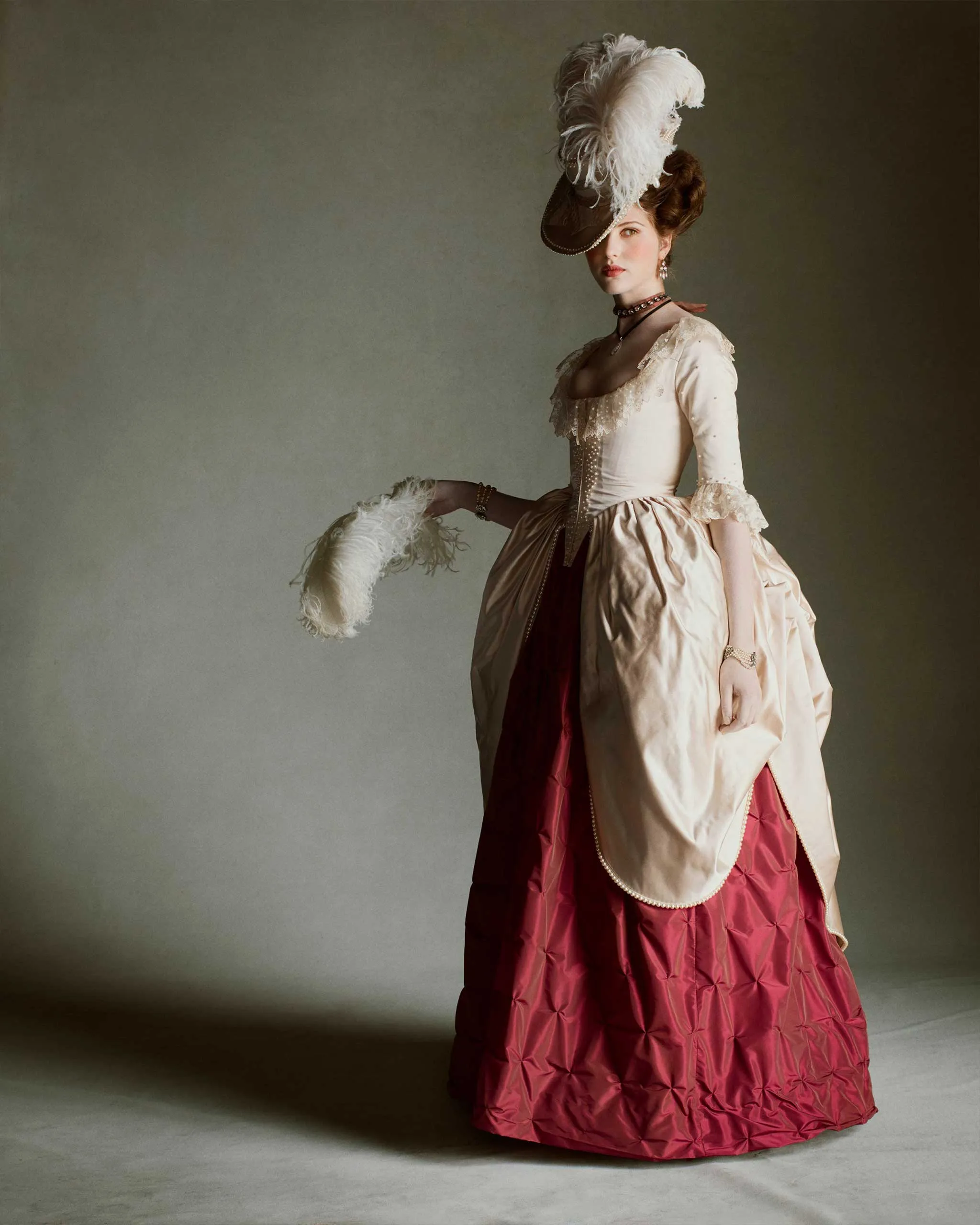Model Angelina Kendall in a recreation of a costume from Stanley Kubrick’s 1975 historical epic Barry Lyndon, worn by Marisa Berenson. Dress designed by Milena Canonero and Ulla Britt Soderlund executed by Tirelli Costumes. Hat designed by Canonero and executed by Laboratorio Pieroni. Larkspur & Hawk necklace and Fred Leighton necklace (as bracelet). Martin Katz pendant and diamond and ruby ring. Fashion Editor: Alex Harrington.Photographed by Ethan James Green. Vogue, November 2025.
What happens when contemporary fashion designers reinvent or reanimate legendary costume moments from Hollywood history? Here, looks from eight iconic films—Barry Lyndon, Marie Antoinette, Dune, Black Panther, Orlando, Edward Scissorhands, Once Upon a Time…in Hollywood, and The Great Gatsby—meet seven custom looks inspired by the worlds they conjured, real or imagined.
Marie Antoinette, 2006


No one brings imaginary worlds to life quite like the Italian costume designer Milena Canonero, who has four Oscar wins and nine nominations under her belt. In 1986, when she was working on Miami Vice, Vogue noted that when “Canonero costumes a film, ‘costumes’ go beyond compelling visual images. They tell a fashion story.” Although Canonero’s research is extensive, her approach is not that of a documentarian. As she said in a recent interview, “I get inspiration from many sources, mainly artwork and photographs from different periods, [but] it is more about attitudes.” For Vogue World: Hollywood, Louis Vuitton’s Nicolas Ghesquière channels the sensuous rococo richness of the 18th century, which Canonero explored first for Stanley Kubrick in Barry Lyndon and again in 2006 for Sofia Coppola’s delicious Marie Antoinette. The results are proof positive of a comment the costume designer once shared with Vogue: “Period movies have more style.” —Laird Borrelli-Persson
Dune, 2021

When Denis Villeneuve approached Jacqueline West to do the costumes for Dune, her initial response was, “But I don’t do sci-fi!” In fact, that was precisely why Villeneuve was interested. “He said, ‘I want it to be grounded in the past even though it’s the future.’ I think one of the reasons he asked me to do it,” she explains, “was because he liked my work in The Revenant, because I’m grounded in realism.” West, who studied art history in college, looked to medieval references and the ancient art of North Africa and the Middle East for many of Dune’s costumes. But for others, like the Fremen uniforms, she relied on Frank Herbert’s book, which featured very detailed descriptions. “We knew we needed collection areas on the suit for bodily fluids, a system of tubing to carry the water; that it had to look like it would function in the desert as a distillery, and it still had to have some armor aspects, because the Fremen were brilliant fighters.” West often works with a sketch artist to fine-tune her designs, and then she shows it to her director. “I just keep going until I hear Denis say, ‘I deeply love it.’” —Laia Garcia-Furtado

Black Panther, 2018


“Costume designing is about world-building,” says Ruth E. Carter, who won Oscars for her costume designs for both Black Panther and its sequel, Black Panther: Wakanda Forever. But it’s also about the minutiae of individual outfits. When the late Chadwick Boseman tried on his Black Panther costume for the first time, Carter recalls, “it was majestic. It had the power of whatever it is that lives inside people when they see a superhero. I just jumped up and down. The Black Panther was in my office!” Still, there was work to do—including making it easier for Boseman to breathe and move around: “We had someone from the Boston Ballet come in and put gussets under the arm and legs, and we made a special contraption on the nose so he could take it off and VFX would put it back on.” Carter applied the same know-how to the ensembles worn by the Dora Milaje, Wakanda’s all-female royal guard, one of which is seen here on Awar Odhiang, who also models an interpretation by Balmain’s Olivier Rousteing for Vogue World: Hollywood. —José Criales-Unzueta
Orlando, 1992


“I’ve done a lot of films, but there are very few where I was given the amount of artistic license and freedom I had on Orlando,” says Sandy Powell, the award-winning costume designer with three Oscars and three BAFTAs (and thrice as many nominations). Sally Potter’s Orlando, which starred Tilda Swinton, “was a period film, but it had an edge to it because it was slightly stylized; it wasn’t a thousand percent historically accurate.” Powell, who had already worked with the director and the actor on separate projects, considered it “a natural progression” when they all came together on this film, with Swinton herself at the crux of the its costume design. “I can’t design without knowing who’s wearing it—that’s the number one most important thing,” says Powell. “I know the general feeling; I know the kind of thing it could be. It’s not just about physicality and the coloring—it’s about how they present themselves, how they hold themselves. And their opinions really count, because we are building a character. I’m not just putting dresses on people or making somebody look good to go out for the night. It’s making somebody believe in a character.” —LGF
Edward Scissorhands, 1990


“Edward Scissorhands—he was born of the street,” recalls the four-time Academy Award–winning costume designer Colleen Atwood of the legendary ensemble worn by Johnny Depp in the 1990 Tim Burton film of the same name. “He was born from Canal Street and Orchard Street back in the day when there were jobbers selling all kinds of stuff…. We really had the idea of this patched-together person strapped into a costume that was sort of bondage-meets-practicality, and slightly Victorian.”
“Edward is a character of Tim’s imagination,” Atwood continues. “Tim, I always say, is a drawer of people: He has these drawings of sketchy things that came from his imagination that are with him from his imaginative journey for a long time. And that was kind of my starting point.” Atwood has remade the Edward Scissorhands costume, seen here on model Anok Yai, for Vogue World: Hollywood. “[She is] so amazing—what a heavenly creature!” Yai also wears an Edward-ish ensemble by McQueen’s Sean McGirr. —JCU
Once Upon a Time…in Hollywood, 2019


Arianne Phillips has built her career costuming movies featuring real-life characters, be it Bob Dylan and Johnny Cash in James Mangold’s A Complete Unknown and Walk the Line, or Sharon Tate in Quentin Tarantino’s Once Upon a Time… in Hollywood. “I felt that it was my responsibility to represent Sharon in the most authentic way,” Phillips tells Vogue. “She was not only a beautiful and wonderful actress; she was an It girl.”
The faux-python coat Margot Robbie’s Sharon Tate wears to the Playboy Mansion in Once Upon a Time… was modeled on the real-life Ossie Clark piece that Tate wore to the London premiere of Rosemary’s Baby in 1968. (Phillips is a collector of Ossie Clark’s work herself.) “Sharon and Roman Polanski lived in London during the Carnaby Street days,” Phillips says, “and experienced all the wonderful happenings of fashion and rock ‘n’ roll coming together in the late ’60s, right when our film was set.” Tarantino has generously agreed to loan the coat to Vogue World: Hollywood, where Marc Jacobs’s faithful reproduction will also make an appearance. —Nicole Phelps
The Great Gatsby, 2013


The Australian costume designer Catherine Martin is only the second woman to win multiple Oscars in a single year (after Edith Head) and the first to do it twice—once with Moulin Rouge! and again with The Great Gatsby, both of which were directed by her husband, Baz Luhrmann.
“Baz wanted the Gatsby costumes to be rooted in the silhouettes, fabrics, and details of the 1920s, but infused with an energy that would resonate with modern viewers,” Martin says. “He said, ‘I don’t want a nostalgic New York; I don’t want a sepia-toned New York. I want a New York that feels as vibrant, sexy, visceral, and modern as it would have to Zelda and Scott Fitzgerald, or any of the characters in the book.’ I became fascinated by the idealized silhouettes in these drawings, which were often leaner and more stylized than reality,” she continues. “This led me to favor the idealized forms over strict historical accuracy.” Her most treasured memories of Gatsby are “collaborating with Miuccia Prada to reinterpret 1920s style for a contemporary audience in the party scenes.” For Vogue World: Hollywood, Mrs. Prada has created a new vision of Daisy, as seen with the Miu Miu dress here.—Irene Kim
In this story: hair, Jimmy Paul; makeup, Kabuki; manicurist, Yuko Tsuchihashi; tailor, Hailey Desjardins. Produced by Tann Services. Set Design: Julia Wagner.
This article was originally published on Vogue.com.
